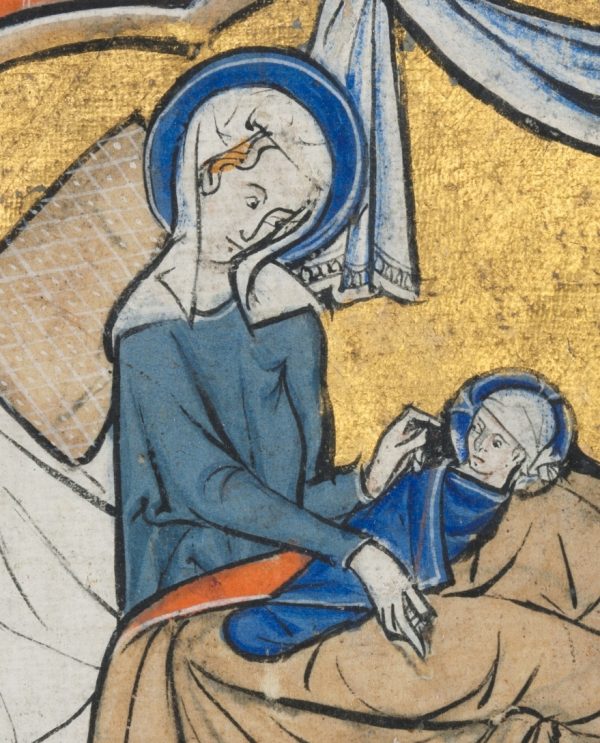We take textiles for granted. But they weave together past and present.
The Globe and Mail , December 18, 2020

When Jesus was born, recounts the gospel of Luke, his mother “wrapped him in swaddling clothes, and laid him in a manger.” The angel who heralded the birth to shepherds in nearby hills said they would recognize “the babe wrapped in swaddling clothes, lying in a manger.”
The manger is the memorable part of the picture, reproduced in countless Christmas pageants and nativity scenes. It has its own traditional carol, Away in a Manger. No song titles celebrate swaddling clothes. A newborn sleeping in an animal trough is distinctive – mythic in its humility. A newborn wrapped in cloth is completely ordinary. Most of us were at birth.
Cloth is a token of common humanity. Its touch is among the most universal of human experiences. We share the need for protection, the drive for status and the pleasures of adornment. Fabric serves all these purposes. We hairless apes co-evolved with our textiles.
In polar regions, they aren’t strictly necessary. Skins and fur suffice for protection. People invented cloth when the Ice Age waned, and animal skins proved too sweaty for warming climes. Today’s winter brings the practical protections of tuques, flannel shirts, moisture-wicking fabrics and synthetic down – heritage and high technology embodied in cloth. We enjoy much more functional fabrics than the shepherds abiding in the hills above ancient Bethlehem or, for that matter, the bundled-up holiday shoppers of decades past.
But textiles do more than shield us from the elements. They provide comfort and joy. Textiles include the braided wicks that light Hanukkah candles and Diwali lamps, the satin ribbons on festive wreaths and special gifts, Santa’s red suit and his bag of toys. “There was once a velveteen rabbit,” begins Margery Williams’ classic children’s story. The tale opens on Christmas morning, with the plush bunny perched atop a gift-filled stocking – a textile-covered toy in a textile container, the knitted garment repurposed for holiday fun. Nowadays, textiles are so cheap and abundant that families dedicate specially made stockings to Christmas cheer.
We take textiles for granted. If, as Arthur C. Clarke famously observed, any sufficiently advanced technology is indistinguishable from magic, the reverse is also true. Any sufficiently familiar technology is indistinguishable from nature. We no more imagine a world without cloth than one without sunlight or rain. Yet textiles represent their own kind of magic – order conjured from chaos, essential artifacts held together by little more than friction.
Just as textiles are a nearly universal human experience, so they also embody the shared legacy of millennia of human ingenuity. That ingenuity stretches back to cave dwellers twisting plant fibres into the first string at least 50,000 years ago, and forward to scientists bioengineering yeast to produce vegan silk.
Every scrap of cloth represents the solutions to innumerable difficult problems: How do you breed sheep with thick, white fleeces? How do you record weaving patterns so someone else can duplicate them? How do you prevent dyes from fading? Some answers were incremental improvements over centuries, some clever refinements of less-successful inventions, a few one-time leaps of singular imagination.

Take Santa’s red velvet suit. Velvet, like the silk from which it was first made, seems to have travelled west from China to the Islamic world and from there to Europe. By the Renaissance it was one of the most prestigious of fabrics. Soft, lustrous and tricky to weave, velvet dressed the rich and powerful. It added grandeur to church altars and priestly vestments. Only in the 19th century did the combination of power looms and new silk hybrids from Japan make velvet a middle-class fabric. Today, Venetian handweavers produce about a half metre of plain velvet a day. Industrial looms turn that much out in seconds.
Santa costumes traditionally featured a cheaper version of the fabric – cotton velvet, sometimes called velveteen to distinguish it from silk. The world’s most popular “natural” fibre, cotton in its wild form bears only a passing resemblance to the dense white bolls harvested in the fall on West Texas farms. Wild bolls are small and mostly seeds, and the fibre is very short and more likely to be yellowish than blinding white.
In Africa and the Indus Valley, on the Yucatan peninsula and the coast of Peru, ancient people turned wild cotton into cultivated crops, producing four distinct species that bore more fibre than the wild version. For many centuries, even cultivated cotton was a tree grown only in the tropics. It bloomed as days grew short, producing its bolls in the wintertime. In most of today’s major cotton-growing regions, from Uzbekistan to the southern U.S., frost would have killed the flowers before the fibre-laden seeds emerged. Human artifice turned cotton into the “natural” fibre we know today.
Going from fibre to cloth requires a crucial intermediate step, one that before the Industrial Revolution of the late 18th century was a major bottleneck. Only when machines broke that bottleneck did cotton velvet – a cheaper substitute for a specially woven luxury fabric – begin to make economic sense. Cloth, it turns out, requires a lot of thread to make. And that thread, or yarn, takes a long time to spin.
Prehistoric people around the globe independently invented a simple device for making the large quantities of yarn needed for cloth. Called a drop spindle, it’s a straight stick inserted into a weight made of clay, rock, wood or metal. Holding a mass of clean, brushed fibre to one side, the spinner attaches a bit to the stick, sets it spinning in the air, and maintains just the right tension as the fibre twists into yarn. The spinner keeps feeding fibre into the lengthening thread, winding the yarn around the spindle when it gets too long to hold suspended above the ground. The weight helps to keep the spindle turning like a top. In the hands of an experienced spinner, the process looks like magic. The new thread seems to emerge from the air.
It also looks fast, but it isn’t – at least not when you consider the enormous amounts even a single textile consumes. Consider Santa’s suit, which takes four metres of fabric about 110 centimetres wide. Each square centimetre contains about 45 centimetres of thread: 15 weft threads running back and forth horizontally across the loom and two sets of 15 warp threads extending the full length of the fabric, one to create the structure and the other to make the loops that form the cushy pile.
When you do the math, that’s a lot of cotton yarn: nearly 20 kilometres in all. Spinning that much using a drop spindle could easily take 800 hours. With the more efficient Indian charkha, used by the 18th century’s best and fastest cotton spinners, it would take less – a mere 200 hours, or five 40-hour weeks. That doesn’t include the time to prepare the fibre, dye the yarn or weave the cloth on a loom powered entirely by muscles.
No wonder the Industrial Revolution’s spinning machines changed the world. From clothing to sails, bed linens to flour sacks, plentiful thread made all sorts of essential items much cheaper, more varied, and more easily obtained. It was the beginning of what economic historian Deirdre McCloskey calls “the Great Enrichment,” the economic takeoff that over the next two centuries raised global living standards, making even the world’s poorest people unimaginably rich compared with their ancestors.
Power looms followed in the early 19th century, triumphing despite resistance from the displaced Luddites. A few decades later, synthetic dyes gave birth to the chemical industry, followed by the 20th century’s synthetic fibres – much improved in recent decades. The sawdust-stuffed velveteen rabbit of yesteryear has been succeeded by bunnies with squishy polyester insides and silky microfibre fur.
But children still cling to stuffed animals. Rich, red velvets and bright satin ribbons still delight the hand and eye. Textiles weave together past and present, continuity and change. They are quintessentially human artifacts. Mothers, after all, still surround their babies with cloth – even if we don’t call it swaddling clothes.